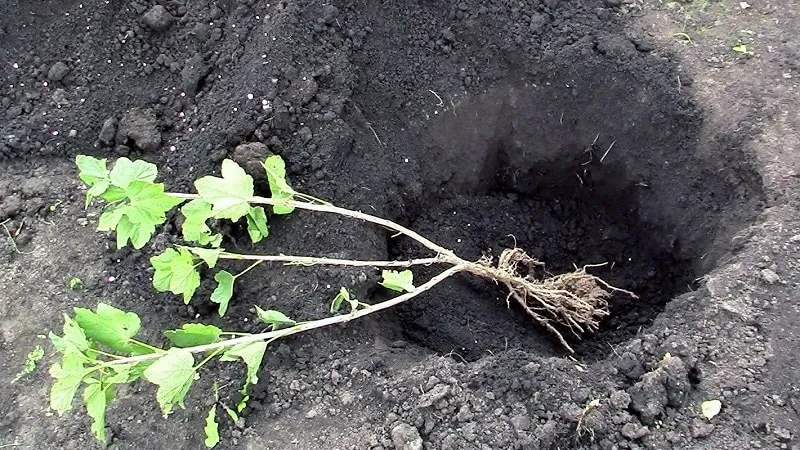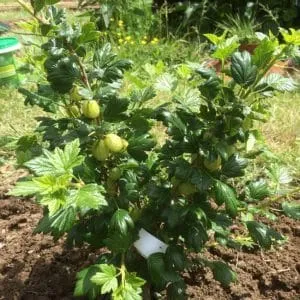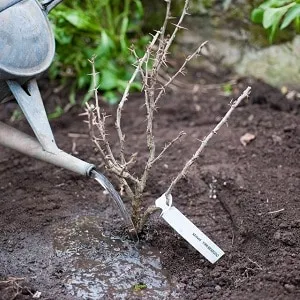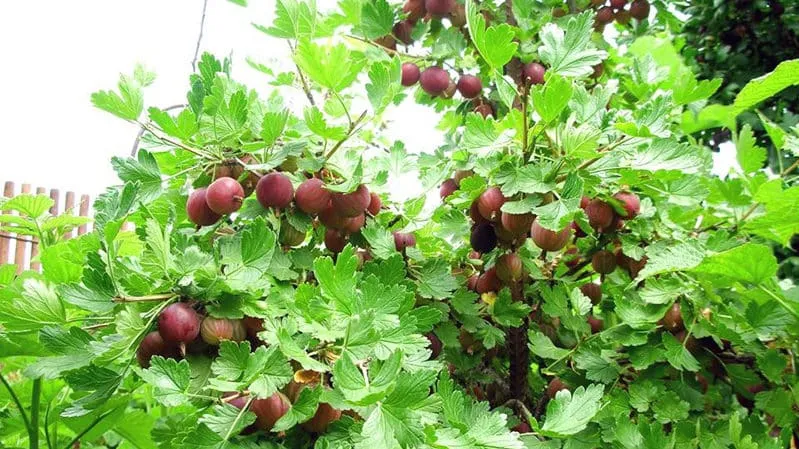Gooseberries are among the highest-yielding berry shrubs. With proper planting, a single bush can produce up to 12 kg of juicy berries and continue fruiting for 20 years or more. The plant is low-maintenance and easy to grow, requiring only a sunny planting spot, moderate moisture, and nutrient-rich soil.
In this article, we’ll discuss the ideal soil type for gooseberries — acidic or alkaline — and the best time for planting.
Table of contents
The Importance of Choosing the Right Soil for Gooseberries

The right soil ensures high yield and early ripening of gooseberries. The most critical requirement for planting is a sunny, open location. Under these conditions, you can expect large, sweet berries.
Good air permeability and moderate moisture are essential soil requirements. If these are neglected, the bushes may become weak and susceptible to powdery mildew.
Avoid planting in low-lying areas or places with high groundwater levels. The water table should be at least 1.5 meters below the surface.
To prevent moisture deprivation, avoid planting gooseberries near trees, maintaining a minimum distance of 2 meters. Trees significantly dry out the soil in their root zones.
Gooseberries should not be planted on hilltops — such areas are prone to drying out. Additionally, bushes in elevated spots are more exposed to frost due to insufficient snow cover.
Important! The thorny nature of gooseberry bushes makes weeding difficult, so remove all weeds before planting.
What Type of Soil Do Gooseberries Prefer?

Gooseberries are less demanding than other berry plants. They thrive in:
- open, sunny locations;
- non-waterlogged areas;
- moderate moisture levels;
- well-warmed soil.
For planting, prioritize well-drained, fertile plots.
Note. If the soil is clay-heavy, add a bucket of sand when planting gooseberries.
Optimal Soil Composition
Loose, fertile, humus-rich soil is ideal for gooseberries. Suitable options include clay, loamy, sandy loam, and sandy soils.
Note. The optimal pH range for gooseberries is 5.5 - 6.5.
Moisture Requirements
Gooseberries dislike excessive moisture, which can cause root rot. However, they tolerate drought well. The soil should feel moist but crumble when squeezed in your hand.
How to Improve Soil for Gooseberries

All soil parameters for gooseberries can be adjusted:
- acidity;
- alkalinity;
- fertility.
Organic and mineral fertilizers are used for this purpose.
Enriching Poor Soil
For nutrient-deficient soil, use an organic fertilizer mix:
- urea — 20-30 g;
- superphosphate — 50 g;
- potassium chloride — 15-20 g.
For best results, apply fertilizers directly to the planting hole. In sandy soil, add a 7 cm layer of clay at the bottom; in clay soil, add sand.
Adjusting Acidity and Alkalinity
A pH below 5 hinders nutrient absorption, particularly calcium and magnesium. In such cases, liming is recommended. The best time for this is early spring. Apply lime powder at 200 g per square meter to a depth of 20 cm and water thoroughly. Repeat no more than once every 5 years.
Fertilizers are an effective way to regulate pH levels.
Common options include:
- potassium sulfate;
- ammonium sulfate;
- potassium chloride;
- superphosphates;
- sodium or calcium nitrate.
These help replace cations with anions in acidic soil, promoting alkalization.
Preparing Gooseberries Before Planting
Before planting, trim broken or dried roots with pruning shears.
Not all saplings are suitable for planting. Age matters more than size — younger plants adapt faster. Inspect the roots for dryness. Check the bark’s health by peeling a small section: green underneath indicates vitality, brown suggests decay.
Remove any leaves before planting, as they dehydrate the sapling. Store saplings wrapped in damp cloth and a plastic bag if delayed planting.
Caution! Avoid damaging buds when removing leaves.
For temporary storage, bury saplings in a shallow trench at a southward angle, covering roots and half the shoots. Water generously to sustain them for weeks.
Prepare planting holes based on root size.
Add to each hole:
- 1-2 kg of compost;
- 90 g superphosphate;
- 100 g wood ash.
Mix well, fill the hole, and water. Spread roots evenly, cover with soil, firm the ground, and water again (10 liters per bush). Mulch with peat, compost, or dry soil (5 cm layer).
Plant the root neck 5-6 cm deep. Prune shoots post-planting, leaving 3-4 healthy buds per stem. Seal cuts with grafting wax.
Soil Care for Gooseberry Cultivation

Regular soil loosening is crucial, especially after autumn rains or spring thaw. Compacted soil retains less moisture and restricts root aeration.
Weed diligently — they compete for nutrients and harbor pests.
Water during dry spells and mulch around bushes.
Caution! Water only at the base — wet leaves increase disease risk.
During flowering and fruiting, apply organic fertilizers (5 kg per bush):
- compost;
- peat;
- well-rotted manure.
In early autumn, clear debris and burn fallen leaves to eliminate pathogens.
Loosen soil 10-12 cm between rows and 3-4 cm near stems, repeating 5 times per season.
Create a soil mound around the bush to protect against pests.
If powdery mildew appears (white coating), treat accordingly:
During growth:
- 5 g soda ash;
- 50 g soap;
- 10 L water.
Spray weekly. Remove infected berries and leaves.
Pre-budding treatment:
- iron sulfate (3%);
- copper sulfate (1%);
- commercial fungicides (follow label instructions).
Repeat treatment 10-12 days post-flowering.
Prune in autumn, leaving 6 healthy, evenly spaced stems. Insulate bushes with snow in winter.
Additional Conditions for Successful Gooseberry Growth

Gooseberries are sun-loving — shade reduces yield and sweetnes. Plant in open, wind-sheltered areas. Ideal rooting temperatures: +10°C day / +5°C night.
When to Plant Gooseberries
Autumn (late September - early October) is optimal, allowing 2 weeks before frost. Spring planting follows the same method.
Tip! Autumn plantings benefit from peat or leaf mulch.
Conclusion
Gooseberries are low-maintenance. Ensure sunlight, proper watering, and soil care for abundant harvests. Their versatile berries — green, red, yellow, or purple — excel in fresh and processed forms, from jams to wines.







